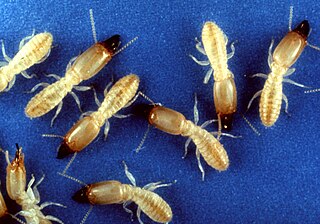An anaerobic organism or anaerobe is any organism that does not require molecular oxygen for growth. It may react negatively or even die if free oxygen is present. In contrast, an aerobic organism (aerobe) is an organism that requires an oxygenated environment. Anaerobes may be unicellular or multicellular. Most fungi are obligate aerobes, requiring oxygen to survive. However, some species, such as the Chytridiomycota that reside in the rumen of cattle, are obligate anaerobes; for these species, anaerobic respiration is used because oxygen will disrupt their metabolism or kill them. Deep waters of the ocean are a common anoxic environment.
A chemotroph is an organism that obtains energy by the oxidation of electron donors in their environments. These molecules can be organic (chemoorganotrophs) or inorganic (chemolithotrophs). The chemotroph designation is in contrast to phototrophs, which use photons. Chemotrophs can be either autotrophic or heterotrophic. Chemotrophs can be found in areas where electron donors are present in high concentration, for instance around hydrothermal vents.

Reticulitermes flavipes, the eastern subterranean termite, is the most common termite found in North America. These termites are the most economically important wood destroying insects in the United States and are classified as pests. They feed on cellulose material such as the structural wood in buildings, wooden fixtures, paper, books, and cotton. A mature colony can range from 20,000 workers to as high as 5 million workers and the primary queen of the colony lays 5,000 to 10,000 eggs per year to add to this total.
Fibrobacterota is a small bacterial phylum which includes many of the major rumen bacteria, allowing for the degradation of plant-based cellulose in ruminant animals. Members of this phylum were categorized in other phyla. The genus Fibrobacter was removed from the genus Bacteroides in 1988.
In biology, syntrophy, synthrophy, or cross-feeding is the phenomenon of one species feeding on the metabolic products of another species to cope up with the energy limitations by electron transfer. In this type of biological interaction, metabolite transfer happens between two or more metabolically diverse microbial species that live in close proximity to each other. The growth of one partner depends on the nutrients, growth factors, or substrates provided by the other partner. Thus, syntrophism can be considered as an obligatory interdependency and a mutualistic metabolism between two different bacterial species.

Trichonympha is a genus of single-celled, anaerobic parabasalids of the order Hypermastigia that is found exclusively in the hindgut of lower termites and wood roaches. Trichonympha’s bell shape and thousands of flagella make it an easily recognizable cell. The symbiosis between lower termites/wood roaches and Trichonympha is highly beneficial to both parties: Trichonympha helps its host digest cellulose and in return receives a constant supply of food and shelter. Trichonympha also has a variety of bacterial symbionts that are involved in sugar metabolism and nitrogen fixation.
Rudolf K. Thauer is a biologist and a retired professor of microbiology and heads the Emeritus group at the Max Planck Institute for Terrestrial Microbiology in Marburg. Thauer taught in the faculty of Biology at the University of Marburg for about 15 years and is known primarily for his work on the biochemistry of methanogens.
Methanopyrales are an order of microbes within the class methanopyri.
Methanobrevibacter is a genus of archaeans in the family Methanobacteriaceae. The species within Methanobrevibacter are strictly anaerobic archaea that produce methane, for the most part through the reduction of carbon dioxide via hydrogen. Most species live in the intestines of larger organisms, such as termites and are responsible for the large quantities of greenhouse gases that they produce. Mbr. smithii, found in the human intestine, may play a role in obesity.

Archaea is a domain of single-celled organisms. These microorganisms lack cell nuclei and are therefore prokaryotes. Archaea were initially classified as bacteria, receiving the name archaebacteria, but this term has fallen out of use.
Methanobrevibacter cuticularis is a species of methanogen archaeon. It was first isolated from the hindgut of the termite Reticulitermes flavipes. It is rod-shaped, ranging in size from 0.34 to 1.6 µm and possesses polar fibers. Its morphology, gram-positive staining reaction, resistance to cell lysis by chemical agents and narrow range of utilizable substrates are typical of species belonging to the family Methanobacteriaceae. It habitates on or near the hindgut epithelium and also attached to filamentous prokaryotes associated with the gut wall. It is one of the predominant gut biota.
Methanobrevibacter curvatus is a species of methanogen archaeon. It was first isolated from the hindgut of the termite Reticulitermes flavipes. It is rod-shaped, ranging in size from 0.34 to 1.6 µm and possesses polar fibers. Its morphology, gram-positive staining reaction, resistance to cell lysis by chemical agents and narrow range of utilisable substrates are typical of species belonging to the family Methanobacteriaceae. It habitates on or near the hindgut epithelium and also attached to filamentous prokaryotes associated with the gut wall. It is one of the predominant gut biota.
Methanobrevibacter gottschalkii is a species of methanogen archaeon, named after Gerhard Gottschalk.
Methanobrevibacter thaueri is a species of methanogen archaeon, named after Rolf K. Thauer.
Methanobrevibacter woesei is a species of methanogen archaeon, named after Carl R. Woese.
Methanobrevibacter wolinii is a species of methanogen archaeon, named after Meyer J. Wolin.
Methanogenium frigidum is a psychrophilic, H2-using methanogen from Ace Lake, Antarctica.
Methanogenium marinum is a psychrophilic, H2-using methanogen from Skan Bay, Alaska. Its cells are highly irregular, non-motile coccoids, occurring singly. AK-1 is its type strain.
Methanosphaera stadtmaniae is a methanogen archaeon. It is a non-motile, Gram-positive, spherical-shaped organism that obtains energy by using hydrogen to reduce methanol to methane. It does not possess cytochromes and is part of the large intestine's biota.
Methanocalculus halotolerans is a species of archaeon, the type species of its genus. It is an irregular coccoid hydrogenotrophic methanogen. Its type strain is SEBR 4845T.


